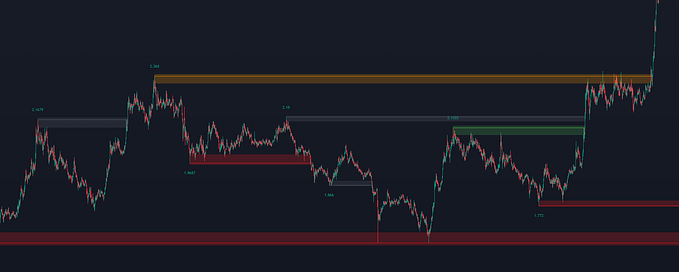Yet Another Intro to OpenLeverage

Leverage trading on existing permissioned centralized exchanges has substantial entry barriers and is costly to operate and maintain, while current decentralized exchanges are also permissioned and only provide limited pairs.
The permissionless nature of AMM-based decentralized exchange changed the landscape by allowing tokens to list at the cost of an on-chain transaction. Many pairs have appeared on DEXs with promising liquidity and volume and form fast-growing and long-tail markets, in contrast to a permissioned structure that would not let users freely margin trade pairs.
OpenLeverage aims to provide an infrastructure to enable a permissionless margin trading market, allowing anyone to create markets, lend and borrow, and connect to trading venues to serve the unsatisfied market. Therefore, no permission is necessary to create a margin trading market for any pair with isolated and market-adjusted risk controls.
The Vision
The founding team of OpenLeverage came from financial securities trading and crypto backgrounds. They are experienced entrepreneurs and specialists with many years of experience in derivatives trading and risk management and building blockchain-based financial systems. They have worked with major institutions, including Goldman Sachs, HSBC, and Louis Dreyfus.
The idea of the project was born from the perceived potential and limitations of trading cryptocurrencies. There is a lot of DeFi growth intertwined with the permissionless nature of finance. While the premise of decentralized finance sounds alluring, users find it challenging to find permissionless markets when looking for leverage trading. Current decentralized leverage trading protocols provide limited pairs and market depth and cannot scale to meet demand from rapid market development. The need exists for a secure and permissionless leverage trading facility that serves the fast-growing DeFi market.
OpenLeverage wants to enhance the trading experience for the user. The team envisioned building a permissionless lending and margin trading protocol with aggregated DEX liquidity, which would enable traders to long and short any trading pair on DEXs efficiently and securely.
For the long term, OpenLeverage aims to build a decentralized crypto securities service to retail and institutional clients, providing decentralized lending, derivatives trading, and asset management infrastructure, which integrates with the global DeFi ecosystem.
Core Features
With OpenLeverage, anyone can create a margin trading market as easily as creating a liquidity pool on a platform and allowing hundreds, if not thousands, of tokens to be longed or shorted. There are many features that users find very promising:
- Risk-isolated pools according to pairs’ volatility and calculated risks with prices referenced directly from real-time data from DEXs;
- An anti-price manipulation mechanism detects unreasonable price spikes referred to as the TWAP prices from the DEX.
- Insurance accumulated from transaction fees and interest earned compensate lenders if an insolvency event occurs;
- Integration with the global DeFi ecosystems through yield farms, LToken, and social trading;
- Yield farms that will be deployed to incentivize liquidity providers (LP holders) of supported trading pairs on DEXs, encouraging deeper liquidity and ultimately help traders get less slippage;
- LTokens allow third-party projects and attract their community to provide liquidity to the lending pool, supporting leverage trading to trading pairs on the DEX;
- An intuitive user interface that is informative and easy to use.
OpenLeverage wants to support as many token pairs as possible on DEXs, while other leverage trading protocols only support 20–30 mainstream pairs.
New projects can create lending pools to support margin trading from day one of launch, which is not currently possible. It enables open integration with other DeFi projects technically and tokenomically.
Value Propositions
- Lenders are DeFi users who want to hold their tokens for future appreciation while at the same time earning yield and new tokens as rewards. In today’s DeFi space, holders of emerging tokens can hardly find places to earn yield for their long-tail token holdings.
OpenLeverage protocol provides a peer-to-peer lending facility, allowing token suppliers to lend any token through lending pools. The supplier then earns yield from the borrower who makes a margin trade via OpenLeverage smart contracts.
The money market has been growing for mainstream tokens. The solution aims to unleash the lending and borrowing for hundreds, if not thousands, of fast-growing and long-tail tokens with a permissionless money market.
- Traders/Borrowers are typically DeFi speculators who want to long or short tokens on DEXs. Traders today find it challenging to find permissionless markets when looking for long or short emerging tokens. Most existing decentralized leverage trading protocols provide only minimal pairs, lack market depth, and cannot scale to meet demand from rapid market development.
OpenLeverage provides a permissionless, decentralized, scalable, and secure leveraged trading facility that serves the long tail and fast-growing DeFi market. Moreover, the protocol avoids the potential for price manipulation or capacity failures in DeFi trading.
Decentralized exchange is a rapidly growing marketplace. The cumulative DEX trading daily volume is above 2.9 billion dollars, and there are more than 3 million unique traders, with significant numbers growing daily.
- Project Owners are individuals or teams that develop and run DeFi projects. DeFi projects tractions today prove to be highly correlated with their token price. Higher token prices give better yield to the protocol users, so project owners are willing to raise token prices. Currently, they find it challenging to find a way to leverage external funds to do so.
OpenLeverage provides a low barrier of entry for project owners to create and operate a leveraged trading market for their tokens. LToken, as an economic integration hook, enables external projects to incentivize their users to deposit their funds into the OpenLeverage lending pools.
- Liquidity Farmers are token holders who participate in liquidity provision on DEXs or staking tokens on project-owned yield farms. Liquidity farmers look for an alpha return, but at the same time are exposed to the volatility of the market (beta risk). They find it difficult to hedge impairment loss or volatility risk because a leveraged market does not exist for them to have a short position on those fast-growing and long-tail tokens.
OpenLeverage provides a perfect way for them to organize a margin trading market and short tokens to hedge the beta risk while enjoying a high yield on alpha.
- DEXs (Decentralized Exchanges) that run with the AMM model. Decentralized exchanges always look to attract trading volume and to have better liquidity on their platform.
OpenLeverage acts as a brokerage to help DEXs to generate more trading volume via margin trading on the spot market, which leads to more fees generated from transactions and higher yield for Liquidity Providers, therefore better liquidity on DEX. They will also deploy yield farms to incentivize Liquidity Providers on certain pools to improve liquidity for traders to enjoy minor slippage and overall better risk management. Therefore, LPs on the DEX have extra rewards for staking in liquidity pools.
Utility of Tokens
OpenLeverage will have a dual-token system with $OLE and xOLE to incentive protocol usage and governing proposals.
- $OLE is a native token minted by protocol usage — borrowing/trading, lending, facilitating liquidation, and yield farming.
- $OLE holders lock $OLE token into a time-weighted voting escrow to receive xOLE, which has voting power on governance proposals and is eligible to receive generated fees from margin trades, along with other privileges.
More about OpenLeverage Tokenomics.
Roadmap
OpenLeverage Protocol was deployed to Ethereum in December 2021, integrating with Uniswap V2/V3 and SushiSwap, and recently deployed to BNB Chain in Feb 2022, integrated with PancakeSwap, Mdex and BabySwap. Within three to six months, OpenLeverage plans to have multi-chain deployments, connecting more top AMM DEXs on Avalanche, Polygon, and Fantom, and Layer-2 solutions such as Arbitrum and Optimism.
Native $OLE tokens and OpenLeverage DAO will launch to boost protocol usage with decentralized governance later in 2022. From Q1 2022 onwards, there are planned extensions and enhancements to the protocol, with priorities including limit order for spot and margin trading for any token on DEXs, tranche lending with smart vault, and with a long-term direction towards becoming Web3 based Social Network for DeFi communities.
OpenLeverage wants to promote a positive user experience — users want to have a better overview of the market and have a better method for entering the market.
Progress
There is a dedicated team working eagerly and tirelessly on the project. OpenLeverage has been enhancing its products and integrating to promote a more positive user experience while creating a community-based solid marketing brand. OpenLeverage has reached several milestones:
- Launched on Ethereum Mainnet on December 20 2021, and BNB Chain on 22 Feb 2022;
- Accumulated with 11m trading volume and 3.5m TVL with 360% growth weekly in the Q1 2022;
- Invited to present at the Uniswap Community Call in September to discuss how OpenLeverage should better integrate to benefit both communities;
- Participated in the Creative Destruction Lab (CDL) Blockchain Program in 2021/2022, where they were mentored by industry leaders that included Josh Felker, Ash Fontana, and Jeff Enslin;
- Integration with EPNS to provide real-time notifications on price movements and liquidations.
- Partnered with PancakeSwap, Solv Protocol, Fuse Network, Infinity Pad, Mdex, on volume and liquidity boosting campaigns across many communities.
Community
OpenLeverage has initiated a top-down approach in unison with a grassroots campaign with their communities. They have instituted an open and direct branding, along with clearly defined differentiators. Top-tier media, notable investors, and KOLs chose to collaborate with OpenLeverage to help bring the protocol direct to users.
The OpenLeverage team has conducted over 30+ AMA sessions, reaching over 500,000 global users. The team actively engages their community members, with 8 Weekly Missions conducted with more than 10k participants and over 3,000 responses. Their social channels include over 30.6k Twitter followers, 20.5k Discord members, and 6k Telegram members. (As of Mar 2022)
OpenLeverage requested the community response to the assets they want to support for lending and margin trading at protocol launch, called the Genesis Markets. The response was overwhelming on Twitter, with over 3.2k responses, over 11k retweets, and more than 8.2k likes.
Contact
The OpenLeverage team will be available to answer questions in the community Discord.
To get involved and stay up to date:
- Official Web: https://openleverage.finance
- Follow us on Twitter
- Check out our GitHub
- Subscribe to the blog
- Find frequently asked questions here








